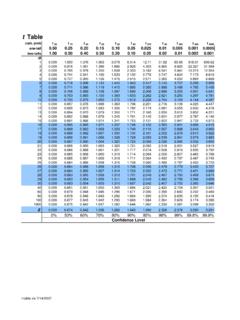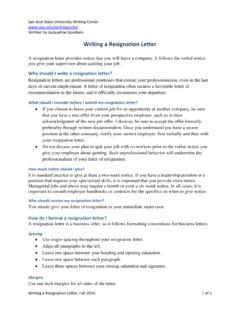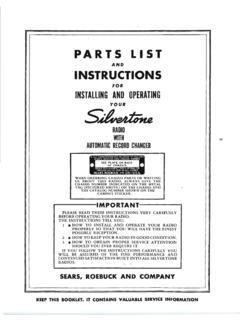Transcription of Introduction to Scanning Electron Microscopy
1 Introduction to Scanning Electron Microscopy By: Brandon Cheney Ant s Leg Integrated Circuit Nano-composite This document was created as part of a Senior Project in the Materials Engineering Department at San Jose State University. It is intended to provide an Introduction Scanning Electron Microscopy and techniques for better imaging. References are provided at the end of the paper for those who wish to study the subject more thoroughly. 1. Introduction The SEM instrument is made up of two main components, the electronic console and the Electron column. The electronic console provides control knobs and switches that allow for instrument adjustments such as filament current, accelerating voltage, focus, magnification, brightness and contrast.
2 The FEI Quanta 200 is a state of the art Electron microscope that uses a computer system in conjunction with the electronic console making it unnecessary to have bulky console that houses control knobs, CRTs, and an image capture device. All of the primary controls are accessed through the computer system using the mouse and keyboard. The user need only be familiar with the GUI or software that controls the instrument rather than control knobs and switches typically found on older style Scanning Electron microscopes. The image that is produced by the SEM is usually viewed on CRTs located on the electronic console but, instead with FEI the image can be seen on the computer monitor. Images that are captured can be saved in digital format or printed directly.
3 2. Electron Column The Electron column is where the Electron beam is generated under vacuum, focused to a small diameter, and scanned across the surface of a specimen by electromagnetic deflection coils. The lower portion of the column is called the specimen chamber. The secondary Electron detector is located above the sample stage inside the specimen chamber. Specimens are mounted and secured onto the stage which is controlled by a goniometer. The manual stage controls are found on the front side of the specimen chamber and allow for x-y-z movement, 360 rotation and 90 tilt however only the tilt cannot be controlled through the computer system thus there is no need to use all of the manual controls manipulate the orientation of the sample inside the sample chamber.
4 Below is a diagram of the Electron column and a description of each of the components of the Electron column. Figure 2. Scanning Electron microscope column [1]. 1) Electron gun: Located at the top of the column where free electrons are generated by thermionic emission from a tungsten filament at ~2700K. The filament is inside the Wehnelt which controls the number of electrons leaving the gun. Electrons are primarily accelerated toward an anode that is adjustable from 200V to 30 kV (1kV=1000V). 2) Condenser Lenses: After the beam passes the anode it is influenced by two condenser lenses that cause the beam to converge and pass through a focal point. What occurs is that the Electron beam is essentially focused down to 1000 times its original size.
5 In conjunction with the selected accelerating voltage the condenser lenses are primarily responsible for determining the intensity of the Electron beam when it strikes the specimen [1]. 3) Apertures: Depending on the microscope one or more apertures may be found in the Electron column. The function of these apertures is to reduce and exclude extraneous electrons in the lenses. The final lens aperture located below the Scanning coils determines the diameter or spot size of the beam at the specimen. The spot size on the specimen will in part determine the resolution and depth of field. Decreasing the spot size will allow for an increase in resolution and depth of field with a loss of brightness [1]. 4) Scanning System: Images are formed by rastering the Electron beam across the specimen using deflection coils inside the objective lens.
6 The stigmator or astigmatism corrector is located in the objective lens and uses a magnetic field in order to reduce aberrations of the Electron beam. The Electron beam should have a circular cross section when it strikes the specimen however it is usually elliptical thus the stigmator acts to control this problem [1,4]. 5) Specimen Chamber: At the lower portion of the column the specimen stage and controls are located. The secondary electrons from the specimen are attracted to the detector by a positive charge. 3. Vacuum System The ability for a SEM to provide a controlled Electron beam requires that the electronic column be under vacuum at a pressure of at least 5x10-5 Torr. A high vacuum pressure is required for a variety of reasons.
7 First, the current that passes through the filament causes the filament to reach temperatures around 2700K [2]. A hot tungsten filament will oxidize and burn out in the presence of air at atmospheric pressure. Secondly, the ability of the column optics to operate properly requires a fairly clean, dust-free environment. Third, air particles and dust inside the column can interfere and block the electrons before the ever reach the specimen in the sample chamber [1]. In order to provide adequate vacuum pressure inside the column, a vacuum system consisting of two or more pumps is typically present. Separate pumps are required because one pump isn t really capable of doing all the work but, in conjunction they can provide a good vacuum pressure relatively quickly and efficiently.
8 A majority of the initial pumping is done by the action of a mechanical pump often called a roughing pump. The roughing pump operates first during the pump-down process and has excellent efficiency above 10-2 Torr. Although many mechanical pumps used in SEMs are capable of producing pressures better than 5x10-5 Torr, a very long pump down time would mostly be required. Pressures lower than 10-2 Torr are more easily acquired by the action of a turbo-molecular pump. Turbo-molecular pumps make use of a turbine that rotates at 20,000 to 50,000 rotations per minute to evacuate gas molecules and particulates found inside the column [7]. Turbo-molecular pumps are expensive and sensitive to vibrations thus it is important to remember that sudden jolts to the instrument can not only affect the beam but, the severely damage turbo pumps.
9 The FEI Quanta 200 is design to operate in three separate vacuum modes, high vacuum (10-6 to 10-7 Torr), low vacuum ( to 20 Torr) and ESEM ( to 20 Torr) [6]. In the low vacuum and ESEM mode of operation the pressure inside the specimen chamber operates at a lower pressure than that inside the actual column which is always at high vacuum. The high vacuum mode is typically where most SEMs operate. In this mode the highest resolutions and magnifications can be achieved although, it is not suitable for all specimens. Generally anything that is conductive and has a high density works well in high vacuum mode. Specimens that are non-conductive or have a low density are more suitable for the low vacuum or ESEM mode. The ESEM mode of operation is necessary for wet, non-conductive samples.
10 4. Electron Beam-Specimen Interactions Originally Microscopy was based on the use of the light microscope and could provide specimen resolutions on the order of microns. To achieve higher resolutions, an Electron source is required instead of light as the illumination source, which allows for resolutions of about 25 Angstroms. The use of electrons not only gives better resolution but, due to the nature Electron beam specimen interactions there are a variety of signals that can be used to provide information regarding characteristics at and near the surface of a specimen. In Scanning Electron Microscopy visual inspection of the surface of a material utilizes signals of two types, secondary and backscattered electrons. Secondary and backscattered electrons are constantly being produced from the surface of the specimen while under the Electron beam however they are a result of two separate types of interaction.















